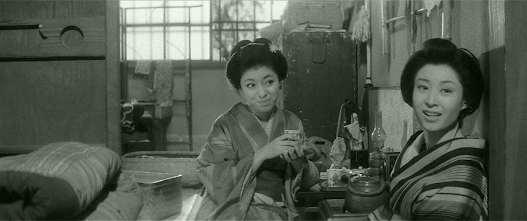Obscure Japanese Film #189
 |
| Takahiro Tamura and Yoshiko Mita |
Shino (Yoshiko Mita) is an amateur geisha working under the name of O-Shige at a modest geisha house run by the money-loving Taneko (Michiyo Kogure), where she also lives. This means that she lacks the musical and dancing skills of a true geisha and simply sleeps with men for money – not because it’s the life she wanted to lead, but because she has taken it upon herself to pay off his father’s debts so that he can avoid prison. Shino is involved with Ryukichi (Shigeru Tsuyuguchi), who works informally as Taneko’s procurer, but he’s a lazy sponger, so she’s naturally not in love with him.
One day, Tadasu (Takahiro Tamura) visits the geisha house as a new client. Compared to most of her customers, he’s kind and gentle, and the two fall in love. However, being a former samurai reduced to pickpocketing, he can’t afford to buy her freedom. He resolves to go straight, but meanwhile Ryukichi becomes jealous of their relationship and begins plotting revenge…
Like the previously-reviewed Cards Are My Life, this was one of just five films written and directed by Masashige Narusawa, who was more usually a screenwriter only. This one is an adaptation of a short story by Kafu Nagai first published in 1917 – a story which went on to have a controversial history when a second, pornographic version appeared and began to circulate on the black market. Nagai claimed that somebody else had added the explicit material without his knowledge, but many thought he had written it himself. After the later version was finally posthumously published in 1972, the magazine publisher responsible was taken to court and charged with obscenity. In any case, although Toei studios based their film on the earlier version, their choice of it as material was one of the tentative steps they were taking at the time to introduce more eroticism into their films as a means of competing with television, where such adult themes were not allowed.

Yumiko Nogawa and Yoshiko Mita
As a film set in a single location, albeit with quite an elaborate exterior set as well as the interior one, this was also probably quite a cheap film to make, although it never looks it. Narusawa (who had studied under Mizoguchi) uses long takes with few close-ups and little cutting – a style I’ve always admired as I feel that it promotes naturalistic acting and makes the viewer feel less led by the nose than in the many films which frequently cut from one close-up to another. Cinematographer Juhei Suzuki – who shot 13 Assassins (1963) and Tales of the Inner Chambers (1968) – also deserves credit for his mobile camerawork, which enabled Narusawa to have only 39 cuts in the entire film.
On the other hand, the performances are adequate but not exceptional and the story is not terribly compelling, featuring as it does the types of characters and situations we’ve seen many times before. Narusawa retains the framing device used by Nagai (here featuring narration by a mostly-unseen Eijiro Tono), but I’m not sure it added much. The one really poor choice, though, is the easy-listening jazz score by Harumi Ibe, which just seems out of place in a Japanese period film, especially when the strummed guitar and accordion kick in, which lend a distinctly inappropriate French flavour to the proceedings!
Thanks to A.K.



No comments:
Post a Comment